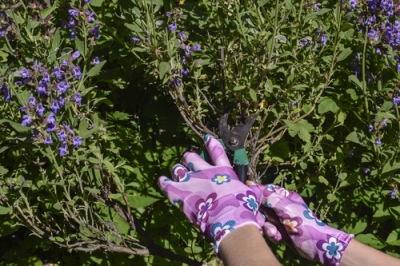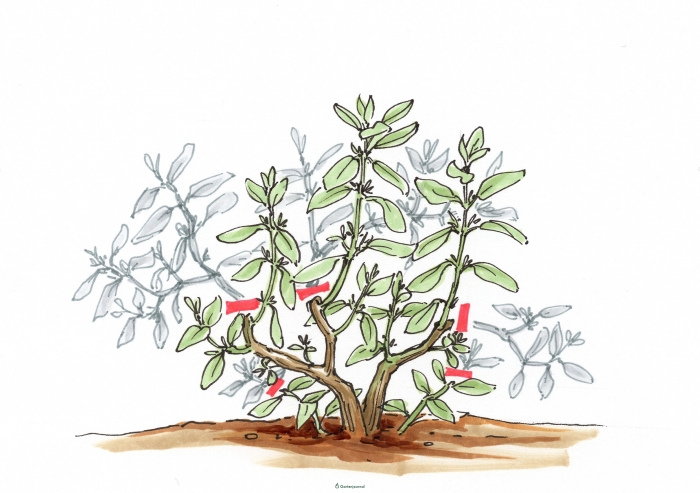Sage should be regularly pruned to perfectly show off its unique advantages. Expert pruning care distinguishes between herbaceous perennials and woody semishrubs. Read in this tutorial when and how to properly prune sage.

Sage species differences
The diverse genus of sage provides home gardeners with gorgeous ornamental shrubs and aromatic spicebushes alike. Each of the two categories delights with compelling attributes, so many gardens feature both varieties. Expert pruning care should take into account the diverse growth so that each sage species shows its best side. Representative of the extensive genus, the following overview summarizes important pruning-related differences for two popular species:
Flowering sage, tumbleweed (Salvia nemorosa)
- Herbaceous growth
- Lavish flowering from May to October
- Inedible leaves and flowers
- Dieback of all above-ground plant parts after first frost
- Fresh shoots in spring from hardy rootstock
Spice sage, garden sage, true sage (Salvia officinalis)
Broad bushy growth as a semi-shrub
Progressive woodiness from base to tip
Herbaceous annual shoots with spicy, edible leaves
Few violet-blue flowers from June to August
Woody shoots predominantly glabrous
Although sage is native to the Mediterranean, both species and varieties derived from them prove to be well hardy in Central European climates.
Cut flowering sage twice a year
In creative garden design, a regular place is reserved for flowering sage in the perennial bed. The inedibility of its felty leaves is made up for by tumbleweed’s lavish summertime blooms, accompanied by wonderful fragrance. Since flowering sage is one of the remontant perennials, it celebrates its colorful appearance twice a season. Accordingly, the scissors are used in spring and summer. How to prune flowering sage correctly:
- In February/March, cut off all shoots at ground level.
- Then fertilize with compost and horn shavings
- Cut back wilted flower stems in mid-July to early August
- Cut about a hand’s width above the ground
Summer pruning should leave some leaves on the stems, so that the perennial can sprout from them again and bloom. Then administer a mineral fertilizer, which quickly exerts its effect and forces growth. If the second flush of flowers is coming to an end, no pruning is done. The dead shoots and leaves act as natural winter protection. Only withered flower spikes you can clean out, unless self-seeding is desired.
Tips
Summer pruning of flowering sage leaves a rather bare patch in the perennial bed for some time. Until the plant sprouts again, beautiful neighboring plants will bridge the waiting period. Associate tumbleweed sage with needle-leaved girl’s eye (Coreopsis verticillata), dyer’s chamomile (Anthemis) or pearlweed ‘Silver Rain’ (Anaphalis triplinervis). Sage also cultivates good neighborliness with lampbush grass (Pennisetum alopecuroides), so there are no empty-swept bed areas.
Spice sage – pruning instructions
Pruning care on spice sage is a constant battle against progressive lignification. Spice sage bears its aromatic leaves primarily on the herbaceous annual shoots. These freeze back completely in the harsh winter and sprout again in the spring. From below, the plant ceaselessly strives to lignify its shoots. Without regular pruning, the woodiness process gains the upper hand and puts an end to the growth of spicy leaves. Consequently, in terms of pruning care, sage pulls together with other Mediterranean beauties, such as lavender and rosemary. Here’s how to do it right:
The best time is between the end of February and mid-March in frost-free weather.
At the beginning, thin out all dead shoots at ground level
Cut back remaining shoots to just above the woody areas.
Following central topiary and maintenance pruning, sage gratefully accepts an organic fertilizer. A combination of mature compost and horn shavings will jumpstart the growth of the herbaceous plant. In August, winter hardiness benefits from a potassium-rich fertilizer, such as comfrey manure.
Pruning optimizes crop yield
Just a few weeks after the main pruning in late winter, sage again becomes the focus of pruning care. In this case, the shears can remain in the shed. If you prune the fresh shoots from mid-May, the measure scores with several advantages. The beginning of the flowering period is delayed, so that the aroma content of the leaves is retained longer. Furthermore, you encourage further herbaceous branching, which increases crop yield and curbs lignification.
To pinch, as de-pinching is called in technical jargon, clasp the tip of a sage stem between your thumb and forefinger. Use your fingernails to pinch off the shoot tip where the next pair of leaves or buds is in waiting position. Of course, you can also use clean, sharp scissors for pinching.
Hedge shears master sage giants
If the chosen location simulates Mediterranean conditions, spice sage will develop expansive dimensions. Devoting attention to each individual shoot with one-handed garden shears takes time and nerves. Well equipped for the annual form and maintenance cut you are with a two-hand hedge trimmer,(105,00€ at Amazon*) ideally with bypass mechanism. As long as you keep the cut in the herbaceous area, the semi-shrub will tolerate the shirt-sleeved approach without any problems.
Rejuvenation pruning reverses lignification
If older shoots are more than half woody or even two-thirds woody, the option is to rejuvenate by derivation pruning. Look along the woody sage branch for an herbaceous side shoot. If you don’t find it, a swelling bud signals that the half-shrub definitely still has potential for herbaceous, aroma-rich growth. The lower down the side shoot or bud, the more pervasive the rejuvenation effect.
Just above the vegetation point, apply the shears. A distance of 5 to 10 millimeters ensures that you neither cut into the herbaceous shoot or bud nor leave an overlong stub. As illustrated below, the recommended pruning significantly reduces the local degree of lignification and paves the way for herbaceous shoots with numerous sage leaves.

Spice sage stingy buds
A typical Mediterranean half-shrub, spice sage goes on the defensive when you cut into the wood. As bountifully as this Mediterranean herb plant sprouts spicy leaves from its herbaceous shoots, it is equally sparing in its disposition of dormant eyes. Native woody plants can draw on this iron reserve to continue growth after vigorous pruning. On spice sage, cutting into the wood usually results in the end of growth. The only exception is in the rare case that you discover a thick, vital bud on the woody shoot. Here, if you place the scissors at a distance of 5-10 mm, there is a good chance of budding.
Harvest and cut at the same time
Sage gardeners with limited time can harvest and prune at the same time. This has the further advantage that you harvest sage exactly when its aroma content is at its zenith. The only prerequisite for this rational approach is sufficient capacity to freeze or dry the excess harvest. This is how you proceed step by step:
The best time is just before the beginning of the flowering period.
Shower the sage bush the day before for a clean harvest
Cut off whole shoots until just above the woodiness
Thin out dead wood, puny or diseased stems at ground level
Never cut into old wood, as growth usually stops at this point. If you limit pruning to the herbaceous, leafy area, new shoots will appear, which, under suitable weather conditions, will provide you with another harvest. Beginning in mid-August, this year’s harvesting and pruning season for sage ends to allow the half-shrub to mature before winter.
Does the combined harvest and maintenance pruning yield more than the kitchen can use? Then pick out unwoody head cuttings. At 5 to 10 inches long, shoot tips are perfect for propagation. Remove all the leaves in the lower half and put each cutting in a pot of growing soil. Rooting progresses quickly in a warm, semi-shaded location with a regular water supply.
Frequently asked questions
Is sage hardy?
The most popular types of sage for beds and balconies are sufficiently hardy. This is true for true sage (Salvia officinalis) and flowering sage (Salvia nemorosa) as well as all varieties derived from them. Silver-leaf sage (Salvia argentea) and muscatel sage (Salvia sclarea) also prove frost-resistant with light winter protection. If you are flirting with extravagant sage species from subtropical regions, there is no question of winter hardiness. This applies, among others, to crested sage (Salvia viridis), honeydew sage (Salvia elegans) and fruit sage (Salvia dorisiana).
Are flowers and leaves of steppe sage edible?
Tumbleweed (Salvia nemorosa) is also called flowering sage, because its advantages are related to decorative aspects. With picturesque flowers, this popular sage species adorns the summer perennial bed from May to October, accompanied by seductive fragrance. If you are aiming for a harvest of spicy leaves and aromatic blossoms, please resort to true sage (Salvia officinalis) or one of its many varieties.
Do we want to transplant our three-year-old spice sage to a sunnier location? When and what is the best time to do it?
The best time to relocate spice sage is in early spring, as long as the plant has not yet sprouted. The less root volume lost when digging, the better the plant will tolerate the procedure. At the new location, plant the sage so that the previous planting depth is preserved. Combine the transplanting work with vigorous pruning to restore the balance between underground and above-ground growth. An adequate water supply is important in the following period to support re-rooting.
Is flowering sage a suitable rose partner?
From a botanical perspective, roses and flowering sage harmonize excellently. Both plant species have similar site conditions and their roots do not get in each other’s way. Furthermore, the essential oils help repel aphids and other pests from roses. Last but not least, flowering sage and roses desire pruning at the same time in the spring.
The wilted blooms on my garden sage do bother me. Can I cut the perennial back now in October?
Radical pruning so close to winter is strongly discouraged. The herbaceous shoots serve as important winter protection even when dead. However, there is nothing to be said against cutting off the withered flower panicles if the well-kept appearance in the bed is affected. After the first frost, flowering sage should not be pruned.
Flowering sage ‘Pusztaflamme’ should actually grow tightly upright. In my garden, it is falling apart and lying partially on the ground. What to do.
Severe heat and drought can cause flowering sage to fall apart. A thrown ball or careless footstep are also typical causes of the mishap. By nature, the perennial grows tightly upright. By cutting all shoots back to a hand’s width above the ground, you’ll encourage renewed growth, and this time, upright growth.
The 3 most common pruning mistakes
If you prune spice sage the same way you prune flowering sage, the worst you’ll experience is total failure of this valuable herb plant. If real sage is not pruned regularly, the shoots will rapidly become woody and will no longer provide a tasty harvest. This table draws attention to common pruning mistakes on sage, points out typical damage patterns and gives brief tips for effective prevention:
Another common pruning mistake affects both spice and flowering sage. Tidy home gardeners are tempted to cut off the dead plant parts prematurely after the onset of winter. By taking this action, the Mediterranean plant forfeits its natural winter protection. Note the date for pruning sage on the care schedule at the end of February at the earliest, provided that no more heavy frosts are expected.
Tips
Cutting back spice sage leaves more clippings than the kitchen can handle. How fortunate that sage leaves retain much of their flavor after drying. Bundle whole shoots into bunches. Hang these upside down in an airy, dry place. Within a week or two, sage leaves will be dry and can be stored in an airtight screw-top jar until ready to use.









